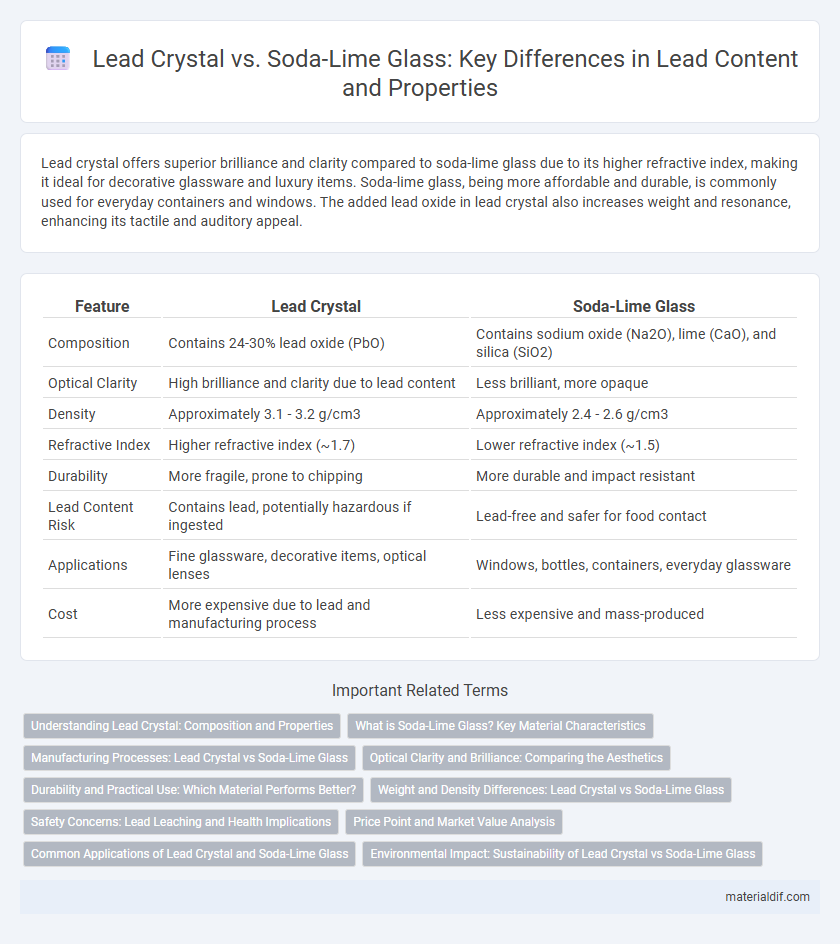Lead crystal offers superior brilliance and clarity compared to soda-lime glass due to its higher refractive index, making it ideal for decorative glassware and luxury items. Soda-lime glass, being more affordable and durable, is commonly used for everyday containers and windows. The added lead oxide in lead crystal also increases weight and resonance, enhancing its tactile and auditory appeal.
Table of Comparison
| Feature | Lead Crystal | Soda-Lime Glass |
|---|---|---|
| Composition | Contains 24-30% lead oxide (PbO) | Contains sodium oxide (Na2O), lime (CaO), and silica (SiO2) |
| Optical Clarity | High brilliance and clarity due to lead content | Less brilliant, more opaque |
| Density | Approximately 3.1 - 3.2 g/cm3 | Approximately 2.4 - 2.6 g/cm3 |
| Refractive Index | Higher refractive index (~1.7) | Lower refractive index (~1.5) |
| Durability | More fragile, prone to chipping | More durable and impact resistant |
| Lead Content Risk | Contains lead, potentially hazardous if ingested | Lead-free and safer for food contact |
| Applications | Fine glassware, decorative items, optical lenses | Windows, bottles, containers, everyday glassware |
| Cost | More expensive due to lead and manufacturing process | Less expensive and mass-produced |
Understanding Lead Crystal: Composition and Properties
Lead crystal contains a significant percentage of lead oxide, typically between 24% and 30%, which enhances its brilliance and weight compared to soda-lime glass. This composition increases the refractive index, resulting in superior light dispersion and a characteristic sparkle that soda-lime glass lacks. The higher density and softness of lead crystal also allow for intricate cutting and engraving, distinguishing it in decorative and luxury glassware.
What is Soda-Lime Glass? Key Material Characteristics
Soda-lime glass primarily consists of silica (SiO2), sodium oxide (Na2O), and calcium oxide (CaO), making it the most common and cost-effective glass type used for windows, bottles, and jars due to its durability and ease of production. Its key material characteristics include moderate hardness, good chemical stability, and a lower refractive index compared to lead crystal, resulting in less brilliance and weight. Unlike lead crystal, soda-lime glass does not contain lead oxide, which reduces its density and lead content, making it safer but less optically vibrant for decorative applications.
Manufacturing Processes: Lead Crystal vs Soda-Lime Glass
Lead crystal manufacturing involves adding lead oxide to the glass mixture, which lowers the melting point and improves clarity and brilliance through controlled slow cooling and annealing processes. Soda-lime glass production uses silica, soda ash, and limestone, melted at higher temperatures and rapidly cooled to create a more durable but less refractive material. The intricate annealing in lead crystal enhances its optical properties, while soda-lime glass prioritizes strength and cost-efficiency in mass production.
Optical Clarity and Brilliance: Comparing the Aesthetics
Lead crystal exhibits superior optical clarity and brilliance compared to soda-lime glass due to its higher refractive index, which enhances light dispersion and creates a sparkling effect. The presence of lead oxide increases the material's density, resulting in a more vibrant and reflective surface, ideal for decorative and fine glassware. Soda-lime glass, while more affordable and durable, lacks the same level of brilliance and clarity, appearing more muted and less luminous in comparison.
Durability and Practical Use: Which Material Performs Better?
Lead crystal exhibits superior clarity and brilliance but is more prone to chipping and scratching compared to soda-lime glass, which offers greater durability and resistance to daily wear. Soda-lime glass is widely preferred for practical, everyday use due to its robustness and affordability. Lead crystal's delicate nature limits its practicality in high-traffic environments where durability is paramount.
Weight and Density Differences: Lead Crystal vs Soda-Lime Glass
Lead crystal has a significantly higher density, typically around 3.1 to 3.2 grams per cubic centimeter, compared to soda-lime glass, which averages about 2.4 to 2.6 grams per cubic centimeter. This difference in density makes lead crystal noticeably heavier than soda-lime glass for the same volume. The increased weight of lead crystal is due to its high lead oxide content, enhancing its brilliance and weight.
Safety Concerns: Lead Leaching and Health Implications
Lead crystal contains lead oxide, which can leach trace amounts of lead into beverages, posing potential health risks with prolonged exposure, especially when used for acidic liquids or stored for extended periods. Soda-lime glass, composed mainly of silica, sodium oxide, and calcium oxide, lacks lead content, making it a safer alternative with minimal risk of toxic metal leaching. Regulatory agencies recommend limiting the use of lead crystal for everyday drinking vessels to reduce lead exposure and safeguard consumer health.
Price Point and Market Value Analysis
Lead crystal commands a higher price point due to its clarity, brilliance, and weight, which justify its premium market value compared to soda-lime glass. Soda-lime glass, being more affordable and widely produced, serves as the standard for everyday glassware with lower market valuation. The lead crystal segment targets luxury consumers willing to invest in craftsmanship and aesthetic appeal, whereas soda-lime glass dominates mass-market applications driven by cost efficiency.
Common Applications of Lead Crystal and Soda-Lime Glass
Lead crystal is commonly used in high-end glassware, decorative items, and luxury lighting fixtures due to its clarity, brilliance, and weight. Soda-lime glass dominates in everyday applications such as windows, beverage bottles, and food containers because of its affordability and durability. Both materials serve distinct purposes based on their optical qualities and cost-effectiveness, catering to different market needs.
Environmental Impact: Sustainability of Lead Crystal vs Soda-Lime Glass
Lead crystal contains lead oxide, which poses environmental and health risks during production and disposal due to lead's toxicity and difficulty in recycling. Soda-lime glass, primarily made from silica, soda ash, and limestone, is more sustainable as it has a lower ecological footprint and is highly recyclable with minimal contamination. The energy consumption for manufacturing soda-lime glass is generally lower, contributing to reduced greenhouse gas emissions compared to lead crystal production.
Lead Crystal vs Soda-Lime Glass Infographic

 materialdif.com
materialdif.com